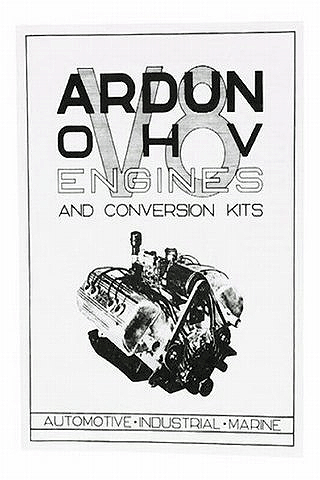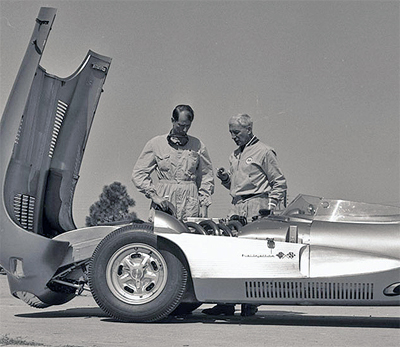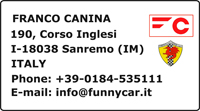
 |
|||||||
|
Il documento sopra riportato è la traduzione, il più fedele possibile all’originale, trascritto sotto. La lettera fu indirizzata a Maurice Olley, capo ingegnere della General Motors, circa sei mesi dopo l’assunzione di Duntov ed il suo trasferimento al Reparto Esperienze Speciali. In questo stesso Reparto era in preparazione la futura Corvette, che molti Autori non considerano quale frutto del lavoro di Duntov. Il fatto per cui il testo è praticamente sconosciuto in Europa, non ne minimizza in alcun modo l’enorme importanza: a seguito delle proposte in esso contenute, negli anni successivi la General Motors scese in campo negli sport motoristici popolari (drag race e stock cars, principalmente) con l’intenzione di riguadagnare il terreno perduto: la mossa spinse gli avversari (Chrysler e Ford) ad ingaggiare lotte epiche su ogni pista agibile con nuove proposte, montagne di “special parts” ed opzioni di tipo sportivo offerte in ogni Concessionaria della Nazione. Il risultato più eclatante della lettera può essere considerato anche la conseguenza verificatasi quasi dieci anni dopo (1962) con l’introduzione delle “muscle cars”, veri concentrati di soluzioni estreme e nuove armi in mano ai tre contendenti. Prima del “memorandum” l’americano medio era convinto che la Chevrolet, produttrice anche di Taxi, fosse una vettura traquilla ed affidabile quanto lo erano, appunto, i taxi che circolavano per centinaia di migliaia di miglia in tutta la Nazione. In capo a meno di una decina d’anni Chevy (il nomignolo affibbiato alla Marca) divenne sinonimo di prestazioni ed oggi, grazie anche a fortunate linee di motori quali lo “small block”, è la marca preferita dagli hot rodders. Un aspetto secondario, ma non certo per importanza, è la testimonianza fornita circa il movimento degli hot rodders, il peso decisivo della Stampa specializzata e dedicata agli hot rodders e l’influenza che questi ultimi potevano avere, ed in effetti hanno avuto, nelle scelte di politica industriale delle tre Grandi di Detroit. |
||||||||||||||||
|
“THOUGHTS PERTAINING TO YOUTH, HOT RODDERS, AND CHEVROLET” The Hot Rod movement and interest in things connected with hop-up and speed is still growing. As an indication: the publications devoted to hot rodding and hop-upping, of which some half dozen have a very large circulation and are distributed nationally, did not exist some six years ago. From cover to cover, they are full of Fords. This is not surprising that the majority of hot rodders are eating, sleeping, and dreaming modified Fords. They know Ford parts from stern to stern better than Ford people themselves. A young man buying a magazine for the first time immediatly becomes introduced to Ford. It is reasonable to assume that when hot rodders or hot rod-influenced persons buy transportation, they buy Fords. As they progress in age and income, they graduate from jalopies to second-hand Fords, then to new Fords. Should we consider that it would be desirable to make these youths Chevrolet-minded? I think that we are in a position to carry out a successful attempt. However, there are many factors againt us: - 1.Loyalty and experience with Ford. - 2.Hop-up industry is geared with Ford. - 3.Law of number-thousands are and will be working on Fords for active competition. - 4.Appearance of Ford’s overhead V8, now one year ahead of us. When a superior line of GM V8’s appeared, there where remarkably few attempts to develop these, and none too successful. Also, the appearance of the V8’s Chrysler was met with reluctance even though the success of Ardun-Fords conditioned them to the acceptance of Firepower. This year is the first one in which isolated Chrysler development met with succsess. The Bonneville records are divided between Ardun-Fords and Chryslers. Like all people, hot rodders are attracted by novelty. However, bitter experience has taught them that new development is costly and long, and therefore they are extremely conservative. From my observation, it takes an advanced hot rodder some three years to stumble toward the successful development of a new design. Overhead Fords will be in this stable between 1956 and 1957. The slide rule potential of our RPO V8 engine is extremely high, but to let things run their natural course will put us one year behind-and then not too many hot rodders will pick Chevrolet for development. One factor which can largely overcome this handicap would be the availability of ready-enginered parts for higher output. If the use of the Chevrolet engine would be made easy and the very first attempts would be crowned with succsess, the appeal of the new RPO V8 engine will take hold and not have the stigma of expensiveness like the Cadillac or Chrysler, and a swing to Chevrolet may be anticipated. This means the development of a range of special parts-camshafts, valves, springs, manifolds, pistons, and such-should be made available to the public. To make good in this field, the RPO parts must pertain not only to the engine but to the chassis coponents as well. In fact, the use of light alloys and brake development, such as composite drums and discs, are already on the agenda of the Research and Development group. These thoughts are offered for what they are worth-one man’s thinking aloud on the subject. Signed: Z. Arkus-Duntov. Dated: 12/16/53
|
||||||||||||||||
 |
||||||||||||||||
 |
||||||||||||||||
 |
||||||||||||||||
 |
||||||||||||||||
 |
||||||||||||||||
 |
||||||||||||||||
 |
||||||||||||||||